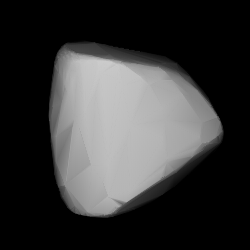Top Qs
Timeline
Chat
Perspective
103 Hera
Main-belt asteroid From Wikipedia, the free encyclopedia
Remove ads
103 Hera is a moderately large main-belt asteroid with an orbital period of 4.44 years. It was discovered by Canadian-American astronomer James Craig Watson on September 7, 1868,[6] and named after Hera, queen and fifth in power of the Olympian gods in Greek mythology. This is a stony S-type asteroid[5] with a silicate surface composition.
Photometric observations made in 2010 at the Organ Mesa Observatory at Las Cruces, New Mexico, and the Hunters Hill Observatory at Ngunnawal, Australian Capital Territory, give a synodic rotation period of 23.740±0.001 h. The bimodal light curve shows a maximum brightness variation of 0.45 ± 0.03 in magnitude.[4]
Measurements made with the IRAS observatory give a diameter of 91.58±4.14 km and a geometric albedo of 0.19±0.02. By comparison, the MIPS photometer on the Spitzer Space Telescope gives a diameter of 88.30±8.51 km and a geometric albedo of 0.20±0.04. When the asteroid was observed occulting a star, the chords showed a diameter of 89.1±1.1 km.[7]
Remove ads
References
External links
Wikiwand - on
Seamless Wikipedia browsing. On steroids.
Remove ads

